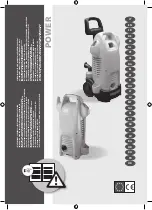
A concrete floor is the most suitable installation surface
for a washing machine, being far less prone to vibration
during the spin cycle than wooden floorboards or a carpeted
surface.
The machine must be level and securely positioned. The
distance between the machine and wall must be more than
10 cm.
To avoid vibrations during spinning, the machine should not
be installed on soft floor coverings.
The machine must stand perfectly level on all
four feet to ensure safe and proper operation.
Incorrect installation may increase electricity
and water consumption and may cause the
machine to move about.
To do these when the machine is not level:
Using the spanner turn locknut in a clockwise
direction. Then turn locknuts together with adjust
feet to unscrew.
Use a spirit level to check the machine is standing level.
Hold adjust feet securely with a pipe wrench. Turn locknut again
using the spanner until it sits firmly up against the housing.
Vibration and noise may occur if the locknuts do
not sit firmly up against the houses.
Drain hose connection
1. Direct into a sink
If the outlet spigot has not been used before, remove any blanking plug
that may be in place.
Push the drain hose onto the spigot and secure with a clip if required,
ensure a loop is formed in the drain hose to prevent waste from the sink
entering the washing machine.
If required, the drain hose can be extended to a length of 4 m.
Loop
“U” piece
supplied
30
cm
60
cm
90
cm
Water inlet connection
Connect the inlet hose supplied with the machine to a tap with a 3/4” thread.
Do not use previously employed hoses.
Installation should comply with local water authority and building regulations’ requirements.
inlet hose for cold water with a white nut
inlet valve for cold water
inlet valve for hot water with a red grid
inlet hose for hot water with a red nut
When there is a inlet valve at the back of the machine, it must be connected to a cold water
supply. If there are two inlet valve, one is connected to a cold water supply and the other
is connected to a hot water supply. Follow the indication of the picture below to complete the
connection.
2. Connected securely to a standpipe.
Firstly form a hook in the end of the drain hose using the “U” piece”
supplied.
Place the drain hose into your standpipe, which should have an internal diameter of approximately
38mm thus ensuring there is an air break between the drain hose and standpipe.
When discharging into a standpipe ensure that the top of the standpipe is no more than 90cm and
no less than 60cm above floor level.




























